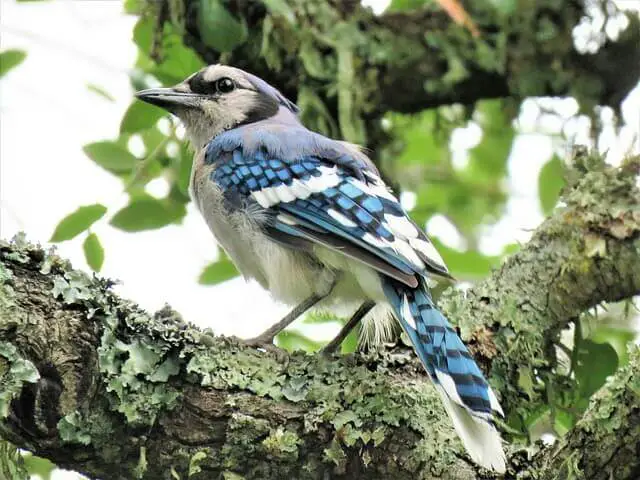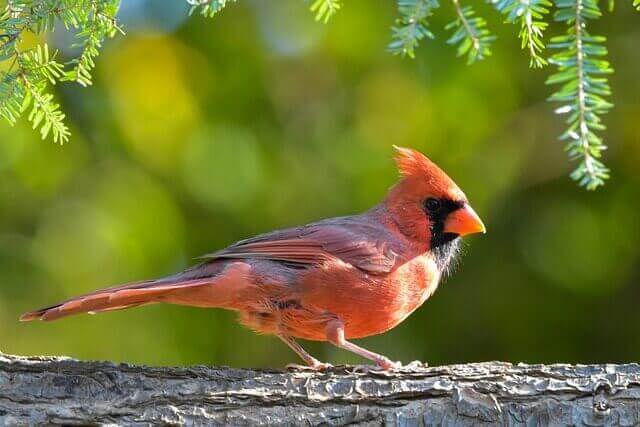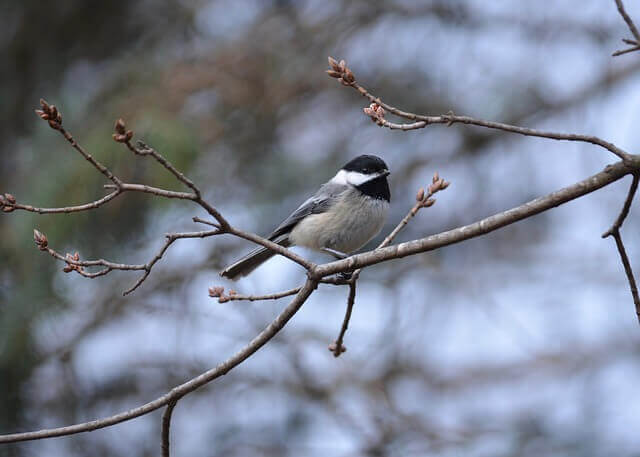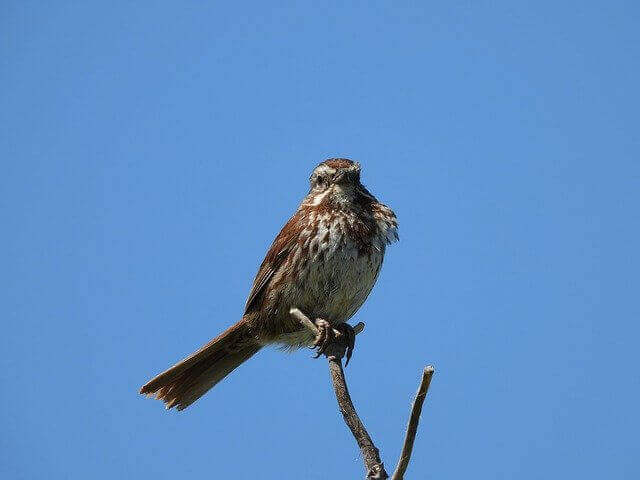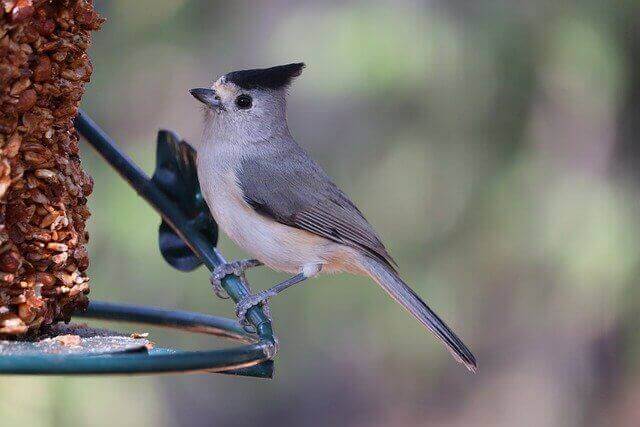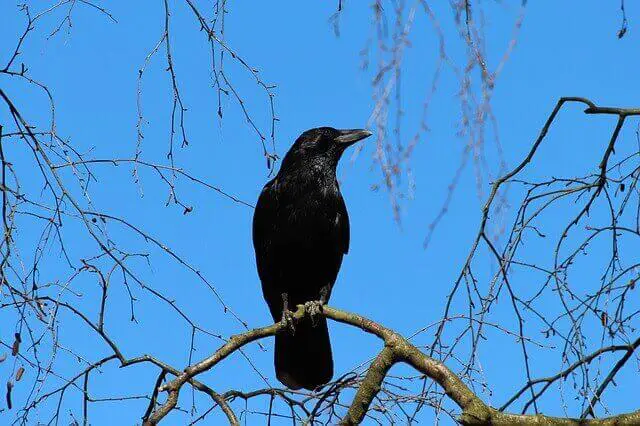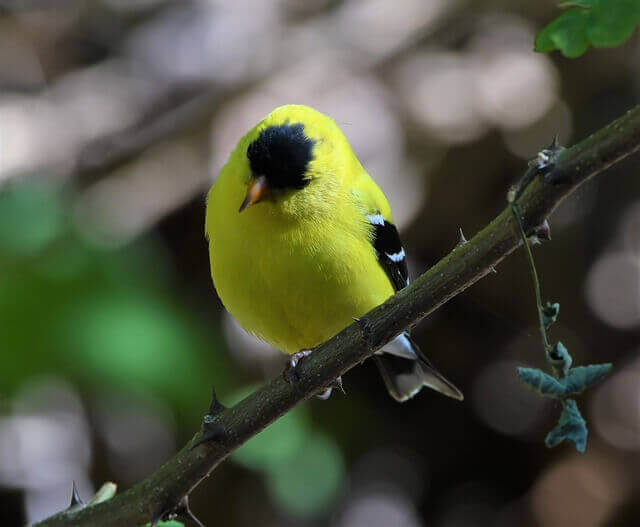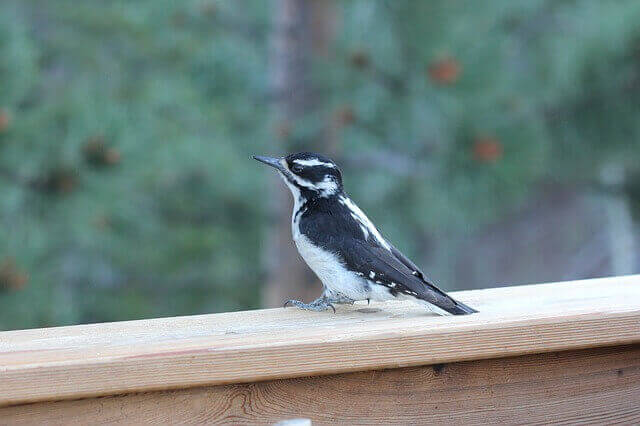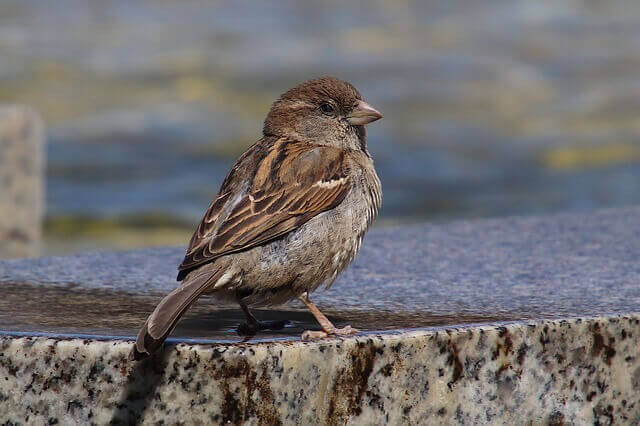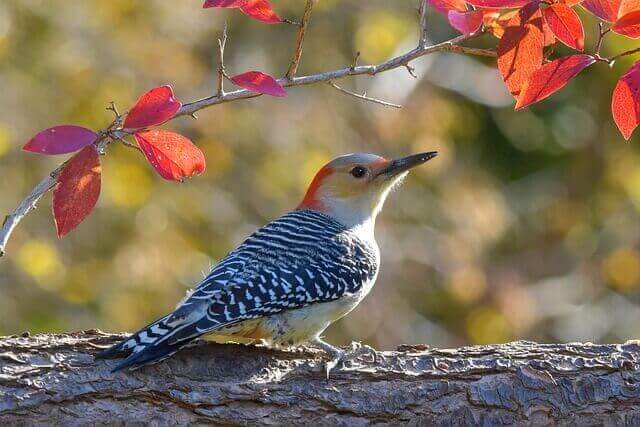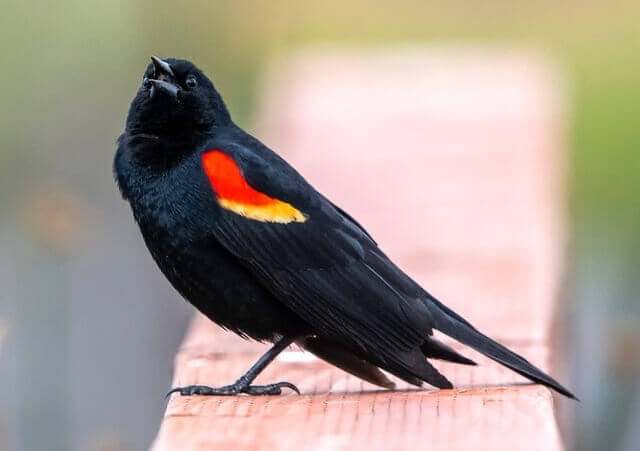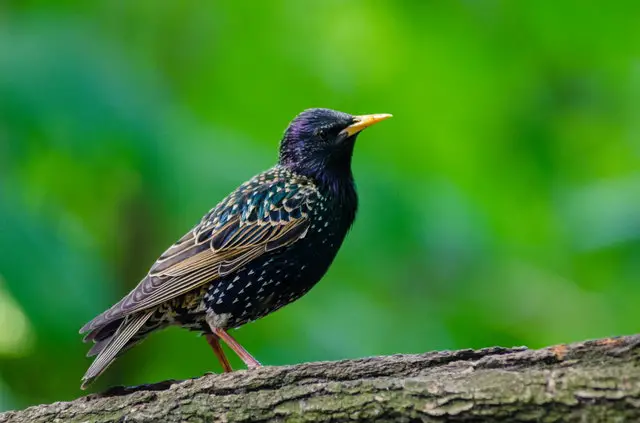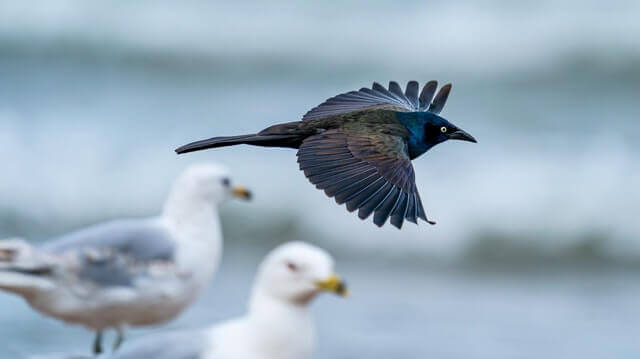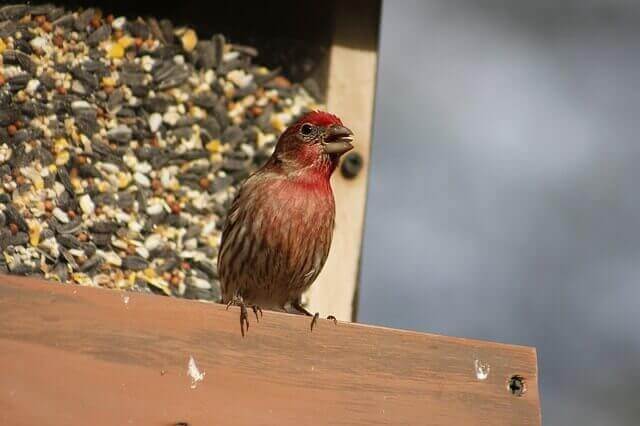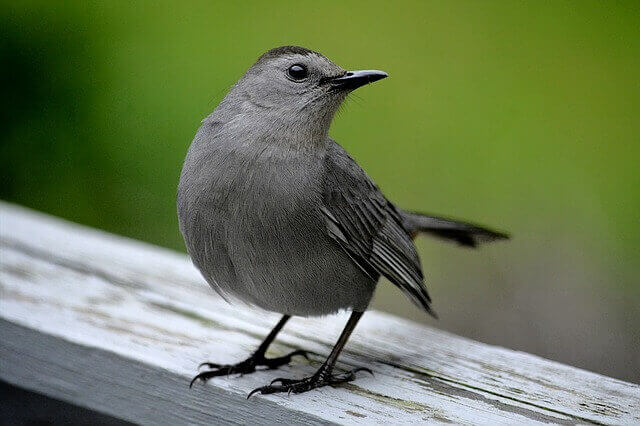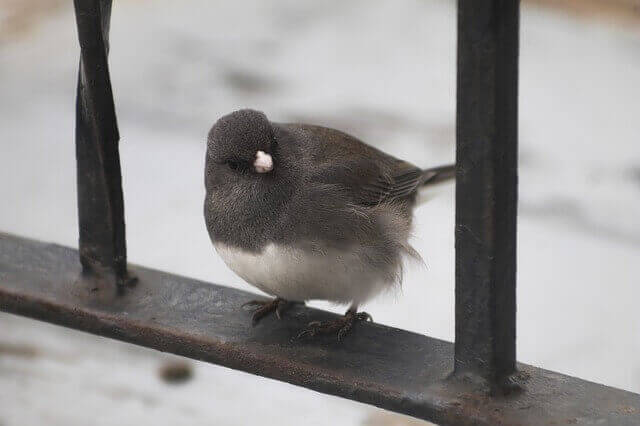Embark on a fascinating exploration of Connecticut’s diverse birding landscape with our comprehensive guide. This Ultimate Guide showcases the 52 most common birds found throughout the Constitution State, offering detailed insights into their habitats, behaviors, and distinctive characteristics.
Whether you’re a dedicated birder, an outdoor enthusiast, or simply curious about Connecticut’s unique birdlife, this guide provides a captivating glimpse into the avian diversity that enriches this historic state.
Table of Contents
- 1 Most Common Birds in Connecticut
- 1.1 Blue Jay
- 1.2 Northern Cardinal
- 1.3 Mourning Dove
- 1.4 Black-capped Chickadee
- 1.5 American Robin
- 1.6 Song Sparrow
- 1.7 Tufted Titmouse
- 1.8 American Crow
- 1.9 American Goldfinch
- 1.10 Downy Woodpecker
- 1.11 House Sparrow
- 1.12 White-breasted Nuthatch
- 1.13 Red-bellied Woodpecker
- 1.14 Red-winged Blackbird
- 1.15 European Starling
- 1.16 Common Grackle
- 1.17 House Finch
- 1.18 Gray Catbird
- 1.19 White-throated Sparrow
- 1.20 Dark-eyed Junco
- 2 Frequently Asked Questions
- 3 Author
Most Common Birds in Connecticut
Blue Jay
The Blue Jay is a common passerine bird in the genus Corvus, native to central and eastern North America. It lives primarily in most of the Midwest and east-central regions of the United States, migratory populations can be found all over central Canada, Alaska, and the northern parts of Europe.
They are found in various habitats including forests, urban areas and suburban areas as well as agricultural fields and gardens. The birds will eat anything from insects to seeds to fruits such as apples or cherries, depending on what they can find at that time of year. Blue Jays typically migrate south for the winter, but populations can vary based on region and climate conditions. In regions
- Frequency: 43.84% (Statistic by: eBird)
- Color: Blue crest on the head, wings, back, and tail, and has a white face and belly.
- Habitat: Deciduous and mixed forests, mixed woodlands, backyards, parks.
- Range: Southern Canada, Eastern and Central United States, Florida and Texas.
- Size: 8.0-12.0″ inches
- Weight: 70-100 grams
- Diet: Nuts, seeds, caterpillars, grasshoppers, and beetles.
- Family: Corvidae
- Genus: Cyanocitta
- Maps: Range Map – Sightings Map
- Sounds: Calls and Songs
Related:
Northern Cardinal
The Northern Cardinal is a type of bird that is found in the Eastern United States. They are mostly found in the eastern region of North America, but can also be seen as far west as Minnesota and Oklahoma. This particular species lives mainly in woodlands, fields, hedges and gardens. Cardinals typically eat seeds from trees such as oak or maple leaves.
Northern cardinals migrate south for winter to warmer climates, where they will live until it starts to get warm up again in late March or early April and return. There are seven main populations in the Connecticut area including the Lincoln Woods, the Westport, the Old Saybrook, the Middle River, the New London, the Stony Brook, and the Conway.
- Frequency: 42.83%
- Color: Mostly red with a black mask on the face
- Habitat: woodlands, gardens, parks, backyards, and wetlands
- Range: USA, Canada, Mexico
- Size: 8.2-9.3″ inches
- Weight: 33-65 grams
- Diet: Fruits, berries, and insects (grasshoppers, beetles, snails, cicadas)
- Family: Cardinalidae
- Genus: Cardinalis
- Maps: Range Map – Sightings Map
- Sounds: Calls and Songs
Related:
- 10 Best Bird Feeders for Cardinals (Rated for 2022)
- Best Birdhouse for Cardinals 2022 (Tested And Rated)
- Cardinal Bird Facts You Never Knew
Mourning Dove
Mourning Doves are a migratory bird that breeds in the southern United States from central Texas to Georgia. The migration pattern of this species is northward during spring to nesting grounds as far north as eastern Nebraska, northern Illinois and Iowa; then southward for winter months into Central America and Mexico.
They can be seen in urban areas as well as natural habitats including deserts, prairies, marshes and forests. The Mourning Dove habitat is usually open fields or grasslands where they feed on seeds such as wheat, barley, corn and millet but will eat almost anything it finds including insects.
- Frequency: 40.58%
- Color: Light gray-brown and lighter and pinkish below. The wings have black spots.
- Habitat: Open habitats, urban areas, farms, prairie, grassland, wooded area
- Range: USA, Canada, Mexico, Central America, Greater Antilles
- Size: 12″ inches length
- Weight: 112 – 170 grams
- Diet: Rapeseed, corn, millet, safflower, sunflower seeds, pokeberry, sesame, and wheat.
- Family: Columbidae
- Genus: Zenaida
- Maps: Range Map – Sightings Map
- Sounds: Calls and Songs
Related: Facts About Mourning Doves – 10 Things You Need To Know!
Black-capped Chickadee
The Black-capped Chickadee has a range that extends from central Alaska east to Newfoundland and south to Missouri and Minnesota in the United States. They inhabit mainly coniferous forests, mixed woodlands, residential areas with mature trees and parks throughout their range.
The diet of the black-capped chickadee includes seeds from trees and plants, buds, fruits and insects. They also eat some tree sap and berries that are high in sugar content, such as elderberries. They also migrate south for the winter to southern California or Texas.
- Frequency: 39.41%
- Color: Black-cap, white on face, white/reddish-brown flanks
- Habitat: Deciduous and mixed forests, backyards, parks
- Range: USA and Canada
- Size: 11.5 -16 cm length
- Weight: 8 – 15 grams
- Diet: Insects, seeds, berries
- Family: Paridae
- Genus: Poecile
- Maps: Range Map – Sightings Map
- Sounds: Calls and Songs
Related: How Do I Attract Chickadees To My Yard?
American Robin
The American Robin is a common sight in the spring and summer months, found in most habitats. They have an extensive range of over 2 million square miles, which makes them one of the most widespread songbirds on earth. Robins are usually found in gardens, yards, parks, or near bodies of water as this provides them with food sources and habitat.
They mainly eat invertebrates such as insects, worms and spiders, but will also eat seeds from plants or berries when there is nothing to eat. During migration season they fly south to warmer climates for winter hibernation from late October through March or April depending on weather
- Frequency: 39.16%
- Color: Mostly brown on the back with an orange-colored breast
- Habitat: Wooded areas, backyards, parks, fields
- Range: USA, Canada, Mexico
- Size: 12 – 16″ inches in length
- Weight: 72 – 95 grams
- Diet: Fruits, berries, and insects (earthworms, beetles, caterpillars)
- Family: Turdidae
- Genus: Turdus
- Maps: Range Map – Sightings Map
- Sounds: Calls and Songs
Related:
- Interesting American Robin Fun Facts
- How To Attract Robins To Your Yard – 7 Best Tips!
- 5 Best Bird Feeders For Robins (Tested & Rated For 2022)
- 9 Birds That Look Like Robins But Aren’t (Photos, & Info)
Song Sparrow
The Song Sparrow is a small bird native to North America. They are commonly found in the United States, Canada and Mexico. The song sparrow’s range spans from Northern British Columbia down to Southern Texas and into Central America. The habitat of this bird varies greatly due to its diverse location.
It can be found in moist deciduous forests, meadows, mixed woodlands or brushy fields with grasses and weeds near water sources such as streams or creeks. They mainly feed on insects, earthworms, seeds and berries. The Song Sparrow migrates during the winter months to avoid colder temperatures in search for food sources which are scarce during this time period.
- Frequency: 16.51%
- Color: Gray head, white cheek, a black bib, rufous neck
- Habitat: Urban centers, farms, backyards, edges, yards, and parks
- Range: Europe, Mediterranean, Asia, Australasia, Africa, and the Americas
- Size: 5.5 – 7.0″ inches
- Weight: 25 – 40 grams
- Diet: Grains, seeds, and insects
- Family: Passeridea
- Genus: Passer
- Maps: Range Map – Sightings Map
- Sounds: Calls and Songs
Related: How to Attract Sparrows to your Backyard
Tufted Titmouse
The Tufted Titmouse is a small songbird that lives in the United States and Canada. Its range includes much of North America, with most populations concentrated in eastern regions. The habitat is often deciduous or mixed forest, but also found in other habitats such as mountain forests, chaparral scrublands and farmland.
They are omnivores, which means they eat both plants and animals; the Tufted Titmouse diet consists mainly of insects (especially caterpillars), ants, beetles, wasps, as well as seeds and berries when they are available. Titmice are known to migrate during the winter months to Central America for the warmer weather, and will migrate back north when spring arrives.
- Frequency: 36.57%
- Color: Gray upper, white front, a tufted gray crest on the head
- Habitat: Deciduous forests, river basin, backyards, swamps
- Range: Canada, USA, and Mexico
- Size: 5.5 – 6.4″ inches
- Weight: 18 – 26 grams
- Diet: Nuts, insects, berries, seeds small fruit, and snails
- Family: Paridae
- Genus: Baeolophus
- Maps: Range Map – Sightings Map
- Sounds: Calls and Songs
Related: How to Attract Tufted Titmouse to my Yard
American Crow
The American Crow is a common bird found in North America. It can be found all over the United States and Canada, but it’s not typically seen in other parts of the world. The American Crow lives mostly on earthworms, insects, small rodents and grains. They have also been known to feed on fruit and berries as well as anything else they find, including carrion (dead animals).
The birds nest high up in trees or other elevated areas, which are safe from predators like hawks. Crows migrate during winter months to avoid the cold climate by flying southward to warmer areas such as Central America or Southern United States where they will spend their winters
- Frequency: 33.91%
- Color: Black
- Habitat: Open country, farms, parks, woodlands, towns, cities
- Range: Canada, USA, Mexico
- Size: 16 – 21″ inches
- Weight: 315 -620 grams
- Diet: invertebrates, carrion, seeds, eggs fish, grains, mice, frogs, and other small animals.
- Family: Corvidae
- Genus: Corvis
- Maps: Range Map – Sightings Map
- Sounds: Calls and Songs
Related:
American Goldfinch
The American Goldfinches range is found from Alaska to Newfoundland and as far south as northern New Mexico. It can be seen in all 50 states of the United States. The goldfinch prefers areas with coniferous trees, scrub oak or mixed deciduous forests for its habitat. They are most often seen around towns, parks and yards because they like bird feeders and people’s gardens for food sources.
The American Goldfinch’s diet consists mainly of seeds such as weed seed, but they also eat some insects and fruit including cherry blossoms during their migration season. During winter months, they migrate southward following the sun to stay warm; usually between September-April for birds living in North America.
- Frequency: 16.41%
- Color: Face, neck, and underside are yellow, black wings with white bars
- Habitat: Deciduous forests and thickets, roadside, grasslands, backyards, meadows
- Range: Canada, USA, and Mexico
- Size: 4.3 – 5.5″ inches length
- Weight: 12 -18 grams
- Diet: Grass, dandelions, chickweed, sunflowers and ragweed, thistle, red alder, birch, spruce seeds
- Family: Carduelinae
- Genus: Spinus
- Maps: Range Map – Sightings Map
- Sounds: Calls and Songs
Related Post: American Goldfinch Interesting Facts
Downy Woodpecker
The Downy Woodpecker is a small bird that inhabits North America and has been observed for the last 50 years. Downy Woodpeckers can be found throughout most of North America, from southern Canada to northern Mexico.
They live in open woodland areas, forests, parks or yards with trees. Their diet consists of insects such as ants or beetles that they find on the ground or from tree bark. Woodpeckers do not migrate; instead, they are very territorial and will remain within an area year-round to feed on seeds during the winter months.
- Frequency: 32.87%
- Color: Black with a white throat, belly, and back. White spots on wings
- Habitat: Deciduous forests and thickets, roadside, grasslands, backyards, parks
- Range: Canada, USA, and Mexico
- Size: 5.5 – 7.1″ inches in length
- Weight: 20 – 33 grams
- Diet: Mostly insects and beetles and ants, also gall wasps, caterpillars
- Family: Picadae
- Genus: Dryobates
- Maps: Range Map – Sightings Map
- Sounds: Calls and Songs
Related:
- How to Attract Downy Woodpeckers to Your Yard? (Easy!)
- 7 Birds That Look Like Downy Woodpecker (Explained)
House Sparrow
The House Sparrow is a member of the Passerine family. The bird can be found throughout North America, Europe and Asia as well as in Africa and Australia. The House Sparrow’s range extends from the Arctic to Central America.
It prefers open habitats such as grasslands or fields with scattered trees for nesting, but will also inhabit urban areas like cities or parks with some vegetation. Their diet consists mainly of insects but also includes seeds, grains, and fruit.
- Frequency: 28.55%
- Color: Gray head marking, a reddish-brown back, and gray underparts
- Habitat: Urban centers, suburban areas, backyards, edges, yards, and parks
- Range: North America, Central America, South America, Africa, Australia, New Zealand
- Size: 5.5 – 7.1″ inches in length
- Weight: 25 – 39 grams
- Diet: Insects, beetles, caterpillars, aphids,, grasshoppers, crustaceans, earthworms, vertebrates
- Family: Passeridea
- Genus: Passer
- Maps: Range Map – Sightings Map
- Sounds: Calls and Songs
Related: How to Attract Sparrows to your Backyard
White-breasted Nuthatch
The White-breasted Nuthatches are very small birds that measure about 6″ inches long. They are native to North America and have a range that extends from southern Canada, south into the United States and eastward into parts of Central America.
These birds can be found in various habitats including coniferous forests, deciduous forests, parks and residential areas as well as at altitudes up to 10 000 feet. They eat insects in summer and seeds in winter from pine cones, spruce cones, birch catkins or various tree buds such as oak buds and hawthorn berries.
- Frequency: 28.40%
- Color: Has a white face, flanks, and chest. It has a black cap on its head a bluish-gray upper and a brown belly
- Habitat: Deciduous forests, conifers, roadside, rivers, backyards, parks
- Range: Southern Canada, USA
- Size: 5.9″ inches
- Weight: 20 grams
- Diet: Acorn nuts, hickory nuts, ants, caterpillars, scale insects, pine weevils
- Family: Sittidae
- Genus: Sitta
- Maps: Range Map – Sightings Map
- Sounds: Calls and Songs
Related Post: How to Attract Nuthatches to your Backyard
Red-bellied Woodpecker
The Red-bellied woodpecker is a medium-sized bird found in North America. They range from the eastern to western coast of Canada and southward through all but central United States.
Red-bellied woodpeckers prefer forests that provide plenty of dead trees and snags for nesting sites and areas with open ground nearby. They primarily eat insects such as ants, beetles and caterpillars which they find on or near tree bark. Their diet also includes other arthropods like spiders or millipedes.
- Frequency: 27.22%
- Color: Gray on body and face and underparts. Black and white pattern on wings, back, and tail.
- Habitat: Forests, backyards
- Range: Southern Canada, Eastern United States, Florida
- Size: 9 – 10.6″ inches long
- Weight: 56 -91 grams
- Diet: Insects, tree frogs, eggs of small birds, oozing sap, and small fish.
- Family: Picidae
- Genus: Melanerpes
- Maps: Range Map – Sightings Map
- Sounds: Calls and Songs
Related: How to Attract Red-bellied Woodpeckers to your Yard?
Red-winged Blackbird
The Red-winged Blackbird is a species of bird that lives in North America. They are found from eastern Canada to the Gulf Coast and as far west as Texas. It is mainly an insectivore, eating things like beetles, caterpillars, flies, wasps and seeds, fruits and berries that have fallen off trees.
The Red-winged Blackbird has been known to inhabit areas such as near wetlands, marshes, ponds or lakes but they can also be seen foraging in dry areas with lots of vegetation. The Red-winged Blackbird migrates south during winter time and then back north again in springtime.
- Frequency: 25.21%
- Color: All black with red patches on shoulder and a yellow wing bar
- Habitat: Deciduous forests, conifers, roadside, rivers, backyards, parks
- Range: North America, Central America
- Size: 6.7 – 7.1″ inches length
- Weight: 41.5 – 65 grams
- Diet: Seeds and insects (butterflies, dragonflies, moths, frogs, worms, spiders, snails, carrion, flies.)
- Family: Icteridae
- Genus: Agelaius
- Maps: Range Map – Sightings Map
- Sounds: Calls and Songs
European Starling
The European Starling is a bird that inhabits the north temperate zone of Europe and Asia. It has also been introduced to North America, where it is most common in the East Coast and parts of California. The European Starling can be found in almost any habitat with trees including parks, gardens, woodland edges, forests, orchards and woodlands.
They nest mainly on the ground but will use ledges or tree holes if available. The diet of the European Starling includes fruits, insects and spiders, seeds from cereal crops such as wheat and barley, juniper berries, hazelnuts and pecans. European Starlings migrate during the winter season when they fly south to warmer climates.
- Frequency: 25.04%
- Color: Black with glossy iridescence plumage
- Habitat: Forests, woodlands, backyards, edges, yards, and parks
- Range: North America, Europe, Africa, India, Middle East, China
- Size: 7 – 9″ inches long
- Weight: 60 – 100 grams
- Diet: Insects (ants, beetles, invertebrates), fruits, seeds, berries
- Family: Picadae
- Genus: Colaptes
- Maps: Range Map – Sightings Map
- Sounds: Calls and Songs
Related: How To Attract European Starlings To Your Yard Fast?
Common Grackle
The Common Grackle is a large blackbird with an iridescent sheen of green, purple and bronze. They are found in the United States and Canada from eastern Texas to Florida, north through Missouri, Michigan and New York. The grackle’s habitat includes wetlands, grasslands, scrubland as well as farm fields.
Their habitat consists of fields, forests, near ponds, streams and suburbs. They are omnivores with a diet consisting of various invertebrates such as insects and earthworms as well as seeds from plants like corn or rice. This species has an annual migration pattern that takes them south for the winter.
- Frequency: 23.58%
- Color: Black overall with a blue, and purple iridescence. Its body plumage is a shimmering copper color.
- Habitat: Woodlands, marshes, meadows, parks, backyards, and fields
- Range: East of the Canadian Rockies, Canada and the United States
- Size: 11 – 13″ inches length
- Weight: 75 – 143 grams
- Diet: minnows, eggs, berries, seeds, grain, insects, frogs, mice
- Family: Icteridae
- Genus: Quiscalus
- Maps: Range Map – Sightings Map
- Sounds: Calls and Songs
House Finch
This bird species is common throughout North America and can be found from the northern US to southern Canada, south to Guatemala and Costa Rica, west across most of the continental United States as well as Alaska. House Finches have a wide range of habitats they occupy including farmland, urban areas, residential neighborhoods and suburban woodlands.
They feed on weed seeds, tree seeds or berries; earthworms, invertebrates, sometimes they feed at bird feeders. House Finches are one of the few songbirds that migrate north for winter but then return south again for breeding season during summer months.
- Frequency: 22.31%
- Color: Reddish face and upper breast, brown streaks on back, belly, and tail.
- Habitat: urban and suburban areas, backyards, edges, yards, and parks
- Range: Canada, USA, Mexico
- Size: 5 – 6″ inches
- Weight: 16 – 27 grams
- Diet: Aphids, grains, seeds, berries, nettle, dandelion, sunflower
- Family: Fringillidae
- Genus: Haemorhous
- Maps: Range Map – Sightings Map
- Sounds: Calls and Songs
Related: How to Attract House Finch to your Yard
Gray Catbird
The Gray Catbird is a small, mostly gray bird that inhabits the eastern half of North America. The Gray Catbird’s range extends from the Atlantic coast to Texas and from Maine west to Wisconsin.
It is primarily found in woodlands, wetlands, orchards and parks with thickets of shrubs and trees as well as along streamsides where it can be observed foraging on the ground for insects, spiders, slugs and snails. They migrate south to spend winter months in Mexico and Central America.
- Frequency: 22.02%
- Color: Mainly Gray with black on tail and head, white accents on the body
- Habitat: Woodlands, marshes, meadows
- Range: East of the Canadian Rockies, Canada, USA, Mexico, Central America, and the Caribbean
- Size: 8 – 9.5″ inches
- Weight: 23 – 57 grams
- Diet: Fruits, berries, earthworms, beetles, bugs, ants caterpillars, grasshoppers, moths.
- Family: Mimidae
- Genus: Dumatella
- Maps: Range Map – Sightings Map
- Sounds: Calls and Songs
White-throated Sparrow
The white-throated sparrows are found in a range from the east coast of Canada to west coast of Mexico. They can be seen in North America and Central America, as well as south through Colombia and Venezuela.
It can be seen at parks, fields, woods, meadows and near lakes during breeding season which occurs April through July. It feeds on insects including beetles, grasshoppers, caterpillars and ants as well as seeds such as clover, grasses, sedges and oats.In winter they will migrate to the southern parts of their range such as Florida or Mexico where it is warmer.
- Frequency: 21.29%
- Color: Brown and gray head pattern. Black-and-white-striped head, white throat, and yellow near the eye.
- Habitat: Deciduous forests and thickets, roadside, grasslands, backyards
- Range: Eastern North America, Atlantic Canada
- Size: 5.9″ – 7.5″ inches long
- Weight: 22 – 32 grams
- Diet: Seeds, insects, and berries
- Family: Passerellidae
- Genus: Zonotrichia
- Maps: Range Map – Sightings Map
- Sounds: Calls and Songs
Dark-eyed Junco
The dark-eyed junco, is a small songbird that can be found throughout the boreal forest of North America. They range from Alaska to Newfoundland and south to Georgia in the east and Oregon in the west. Their habitat includes mixed coniferous forests with low ground cover and willow thickets along streams.
The diet of these birds includes primarily seeds but they are omnivores so may eat other things like insects and spiders and anthropods. Dark-eyed Juncos are nomadic birds with populations travelling as far south as Costa Rica during winter months to escape freezing temperatures up north.
- Frequency: 19.62%
- Color: Gray head, neck, breast, gray/brown backs and wings, white underside
- Habitat: Wooded areas, forest edges, roadsides, gardens, parks.
- Range: USA and Canada
- Size: 5.1 – 6.9″ inches
- Weight: 18 – 30 grams
- Diet: Seeds, insects, and arthropods
- Family: Passeriformes
- Genus: Junco
- Maps: Range Map – Sightings Map
- Sounds: Calls and Songs
Related:
The Backyard Birds below have a Frequency of less than 19% all year-round.
- Carolina Wren – 17.89% Frequency
- Northern Flicker – 16.09%
- Chipping Sparrow – 14.14%
- Northern Mockingbird – 13.06%
- Tree Swallow – 12.94%
- Brown-headed Cowbird – 12.27%
- Eastern Phoebe – 12.22%
- Hairy Woodpecker – 11.56%
- Common Yellow-throat – 10.50%
- Rock Pigeon – 9.84%
- Barn Swallow – 9.76%
- Cedar Waxwing – 9.42%
- Yellow Warbler – 9.41%
- Eastern Bluebird – 8.93%
- House Wren – 8.62%
- Red-eyed Vireo – 8.05%
- Baltimore Oriole – 8.03%
- Yellow-rumped Warbler – 7.37%
- Eastern Towhee – 6.74%
- Ruby-throated Hummingbird – 6.49%
- American Redstart – 6.34%
- Fish Crow – 6.32%
- Killdeer – 6.24%
- Wood Thrush – 6.09%
- Chimney Swift – 5.94%
- Belted Kingfisher – 5.87%
- Ovenbird – 5.75%
- Black-and-white Warbler – 5.64%
- Rose-breasted Grosbeak – 5.20%
- Warbling Vireo – 5.15%
- Veery – 5.02%
- Eastern Wood-Pewee – 5.02%
Frequently Asked Questions
What is the most common bird in New England?
Black-capped Chickadee is the most common bird in New England, with a 55 percent frequency of occurrence. This little bird is found in woods and gardens throughout the region and is known for its distinctive call. The Black-capped Chickadee is a popular backyard bird, and its cheerful song brings joy to many people in New England.
Are there house finches in Connecticut?
In Connecticut, the house finch has a 24 percent frequency of occurrence, which means that it is seen more often than other birds in the state. The house finch is a small bird with a reddish face and breast and a streaky brown body. It is typically found in open areas near human habitation, such as parks and yards.
Are there puffins in CT?
The Atlantic Puffin breeds on coastal areas in the northeastern United States. There have been occasional sightings of puffins in Connecticut over the past few years, but these are very rare. However, that doesn’t mean that you’ll never see a puffin in Connecticut. If you’re lucky enough to spot one of these rare birds, you’re sure to have a truly memorable experience.
Are there wrens in Connecticut?
There are 5 species of wrens in Connecticut! The most common wrens seen in the state are the Carolina wren, house wren, marsh wren, winter wren, and sedge wren. All of these species can be found in wooded areas, although the Carolina and house wrens are also common in urban and suburban areas. Winter wrens are the only species that is typically found in mountainous regions.
Are loons in CT?
There are three species of loons that have been spotted in Connecticut: the Common loon, the Red-throated loon, and the Pacific loon. The common loon is the most likely to be seen, as it is the most widespread species. The red-throated loon is slightly less likely to be seen, as it prefers more northern climates. The Pacific loon is the least likely to be seen in Connecticut, as it is more commonly found near the coast of Alaska.
Are there pheasants in CT?
Yes, there are pheasants in CT. The most common species is the Ring-necked Pheasant. These birds are not native to CT, but were introduced in the early 1900s for hunting purposes. They have since established a small breeding population in the state.
Related Post: 24 Backyard Winter Birds in Connecticut 2022 (Detailed)


